DHL sees the continued importance of road freight in Southeast Asia as companies build supply chain resiliency
Administrator Rabu, 13 November 2024 17:46 WIB

*. DHL's new white paper reveals while progress is being made in Asian road freight, challenges remain, and opportunities to reimagine the movement of freight across the region
*. Countries such as Thailand, Vietnam, Malaysia and Singapore to benefit from its multimodal connectivity
Note to editor: Find out more on how companies can build supply chain resiliency through omnisourcing and multimodal transportation strategies on Logistics of Things.
BANGKOK, THAILAND - 12 November 2024 - DHL Global Forwarding (DHL), the freight specialist arm of DHL Group, said that road freight will continue to play an important and increased role in Southeast Asia, as companies look to build more resilient supply chains. In a new white paper titled "Highway to the Future: Navigating the Road Freight Opportunities in Southeast Asia", DHL outlines the role of road freight as a single or in a multimodal solution, as businesses look to more agility and flexibility in transportation modes for their shipments.
"Over the last few years, we have seen strong export growth in Vietnam, Thailand, and Malaysia. Vietnam is Southeast Asia's largest exporter currently, while Malaysia has strengthened its position as a semiconductor hub. Thailand has made great strides in automobility, particularly in the electric vehicles (EV) sector.
The new DHL International Multimodal Hub at Suvarnabhumi Airport Free Zone 3 will also see Thailand emerge as a regional trade hub. The simplified process will allow goods to be shipped through multiple transport modes, making the country even more attractive for companies looking to expand or move part of their production into Southeast Asia.
While our last whitepaper focused on the emerging use of road freight during the pandemic, our new whitepaper highlights why it remains important even as we see air and ocean freight normalize globally," said Thomas Tieber, CEO, DHL Global Forwarding Southeast Asia and South Pacific.
Countries such as Vietnam, Thailand, Malaysia, and Singapore are set to benefit, especially with their connectivity options, as trade can happen through either road, air, or ocean. These countries also have favorable trade agreements with major economies globally.
Digitalization and improved infrastructure to drive road freight forward
The growing importance of building a resilient supply chain has called for greater agility and transparency with real-time visibility and insights into shipment statuses and road conditions, amidst concerns about security, safety, and stability. Southeast Asia's advanced cellular networks have enabled real-time monitoring of road freight via sensors and GPS units, providing customers with accurate predictions of cargo location and arrival times1.
While global companies are diversifying their supply chain, Chinese companies are also expanding their manufacturing base into the region. In 2023, China's investment into Southeast Asia reached US$24 billion, according to a report by McKinsey. These investments highlight the region's growing importance as a global manufacturing hub, especially with markets such as Cambodia, Laos, Thailand and Vietnam. These countries have announced or implemented improvements or expansions of transportation infrastructure that are vital for logistics. For example, in 2021, Laos opened a new railway linking Vientiane to Kunming in China. Thailand has also opened the new DHL International Multimodal Hub, making it easier for shipments to move in, out, and through Thailand across different transportation modes.
"These investments into making rail or road infrastructure better in Southeast Asia means that it is often cheaper and faster than air to ship from China into Southeast Asia. Road freight plays an important role in a multimodal solution. Moving goods through a combination of transport modes can result in faster Door-to-Door (DTD) lead time compared to ocean freight, with substantially lower cost than air freight," said Bruno Selmoni, VP, Head of Road Freight and Multimodal Solutions, Southeast Asia, DHL Global Forwarding.
Government policies help to streamline cross-border freight
Government initiatives in the Southeast Asia region have provided opportunities to streamline shipments across borders. Countries within the region are also attempting to resolve border issues, collaborate on improving infrastructure, and streamline procedures.
Initiatives like ASEAN's Customs Transit System, ACTS, aim to streamline the processes and reduce paperwork further. The Customs Administrations of all ten ASEAN Member States collectively endorsed the ASEAN Authorized Economic Operator Mutual Recognition Arrangement (AAMRA) in 2023. This agreement establishes a consistent and transparent trading environment within the member states. AAMRA aligns certification standards with the World Customs Organization (WCO) SAFE Framework, ensuring expedited cargo clearance and priority treatment for certified AEOs within ASEAN.
Other than regional agreements, countries in the region have also taken steps independently to facilitate the cross-border movement of goods. Cambodia and Vietnam, for example, have worked together to add lanes to one congested checkpoint.
Growing shift to sustainable road freight in Asia
In a report by International Data Corporation, it is said that 45% of Asian-based organizations will operationalize integrated sustainability in the supply chain by 2026. Freight transportation, including trucks, planes, ships, and trains, contributes approximately 8% of global greenhouse emissions.
A push towards a more sustainable road freight is needed but significant challenges lie ahead. The ASEAN Regional Strategy for Sustainable Land Transport highlighted three categories of green freight policies and measures:
*. Logistics optimization, such as reducing empty hauling, or implementing logistics centers and freight exchanges
*. Use of multimodal such as rail or waterways
*. Greening of trucks either by improving efficiency, low rolling-resistance tires, or alternative fuels
However, achieving this requires aligned efforts from shippers, vehicle manufacturers and government roadmaps.
"A sustainable road freight solution has its challenges but many opportunities, especially when it comes to greening of trucks. We are seeing more electric trucks made available, biofuels used in DHL's fleet in Europe, and upcoming technology like hydrogen fuel being tested. Of course, any solutions will need a comprehensive partnership between the private and public sectors. Governments need to set the appropriate policies and infrastructure, automotive manufacturers need to give viable commercial options, and logistics players like us need to adopt these solutions," explains Selmoni.
For instance, DHL Global Forwarding recently introduced a fleet of electric vehicles in Bangkok, Thailand that is set to eliminate 85,000 kilograms of CO2 emissions yearly. These initial vehicles will cover a monthly distance exceeding 28,000 kilometers in operation and deliver approximately 1,000 tons of shipments to our customers.
"The discussion on road freight is now shifting away from its relevance and cost, but to other challenges on infrastructure and policies which will smoothen the road ahead. Yet at the same time, many of our customers recognize road freight as a key component of their multimodal strategy. This is why it is essential for logistics firms, including DHL, to adapt and anticipate regional trends proactively. This requires an accurate understanding of our customers' specific business landscape. When we align our solutions to the unique shifts brought about by regional dynamics, we help shape the future of logistics in Asia," added Tieber.
The issuer is solely responsible for the content of this announcement.
Berita Terkait
Komentar
0 Komentar
Silakan Login untuk memberikan komentar.
FB Comments






